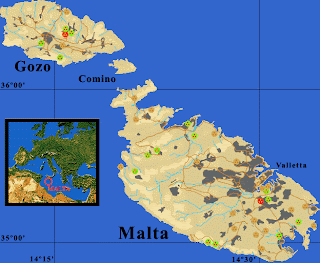Megaliths, medieval dungeons and Calypso's Cave - Malta is positively mythic. The narrow meandering streets of its towns and villages are crowded with Renaissance cathedrals and Baroque palaces. As the countryside is dotted with the oldest known human structures in the world, Malta has rightly been described as an open-air museum.
With 7,000 years of history, the Maltese Islands are steeped in culture and heritage. The Islands went through a golden Neolithic period, the remains of which are the mysterious megalithic temples dedicated to the goddess of fertility. Later on, the Phoenicians, the Carthaginians, the Romans and the Byzantines, all left their traces on the Islands.
There are megalithic monuments, Bronze Age dolmens, Punic tombs, remains of Roman Villas and traces of prehistoric man, which defy explanation, such as the mysterious 'cart' tracks. For three millennia, from around 5200 BC, the archipelago was home to a unique, temple-building civilisation. Malta's temples are thought to be the oldest free-standing buildings known to man.
One site above all others is special to Malta - the Hypogeum, a labyrinth of underground chambers probably used as both a burial site and a temple. The Island's temples qualify as UNESCO
World Heritage Sites and are open to the public. A good place to start your tour is at the National Museum of Archaeology, Valletta or the Hypogeum itself.
With superbly sunny weather, expansive beaches, a thriving nightlife and 7,000 years of intriguing history, there is a great deal to see and do. Everywhere you go, a unique historic sight awaits. Temples, palaces, cathedrals, and forts provide a living history you can almost touch. Sound plays an important part in the life of the Islands. The mix of fireworks and village band marches transforms a summer night into a special memory.
Malta offers an exhilarating contrast of colours: the azure of the Mediterranean, the mellow honey-coloured limestone which characterises the architecture, and clear skies - it is a feast for the senses.
Due to the undoubtedly great advantage of fair weather (average rainfall of 578mm a year and average temperature of 30C/86F during the summer months), the Malta lends itself to outdoor activities.
The first rains after the long, hot summer brings the landscape to life with an astonishing variety of wild flowers. From mid November until mid May the Islands are green and lush with fields full of vegetables and waysides carpeted with fennel, clover, wild iris and myrtle.
Away from the hustle and bustle of villages, Malta offers a great variety of natural spots to be explored and admired, some left almost untouched by the 20th century. Much of the countryside is dotted with the world's oldest free-standing structures in the world, so a stroll could prove to be most interesting.
The Island offers some of the most stunning views anywhere in the Mediterranean. The first thing to do is to decide what sort of view you prefer - dramatic cliffs plunging into waves, the rocky, scrubland of the garrigue or hidden, lush valleys. En route, you'll come across mysterious, prehistoric sites, cave chapels and secluded palaces of the Knights.
One of the best walks is along Dingli Cliffs. It's truly spectacular to watch the sun set over the sea from the highest area in Malta where the land falls away at a spectacular 220m height (720ft).
Valletta is often described as 'a city built by gentlemen for gentlemen'. It is a beautifully preserved sixteenth century walled city with World Heritage status. Being of modest size it is quite easy to access the many attractions including some of Europe's finest artworks, palaces and cathedrals. The National Museum of Archeology should not be missed. Narrow streets are overflowing with quaint shops and cafes.
Mdina, just 5 kilometres away, offers great views of the island and is overflowing with Norman and Baroque architecture. The eleventh century Roman Catholic Sicula-Norman Cathedral's museum is overflowing with interesting artifacts.
Cuisine here is a taste of the Island's multicultural heritage. Local restaurants offer a creative selection of tempting fare.
Typical of the Mediterranean lifestyle, the Islanders' approach to life is to enjoy and celebrate it as much as possible. Nightlife on the Islands is always bustling with scores of clubs and excellent wine bars to visit. You can even enjoy a flutter at one of the casinos.
The long relationship between the Islanders and the various nationalities that occupied Malta over the centuries has created a marriage of styles and traditions, giving Malta a fascinating, eclectic culture.
Malta truly is a little bit of Mediterranean magic!




Comments